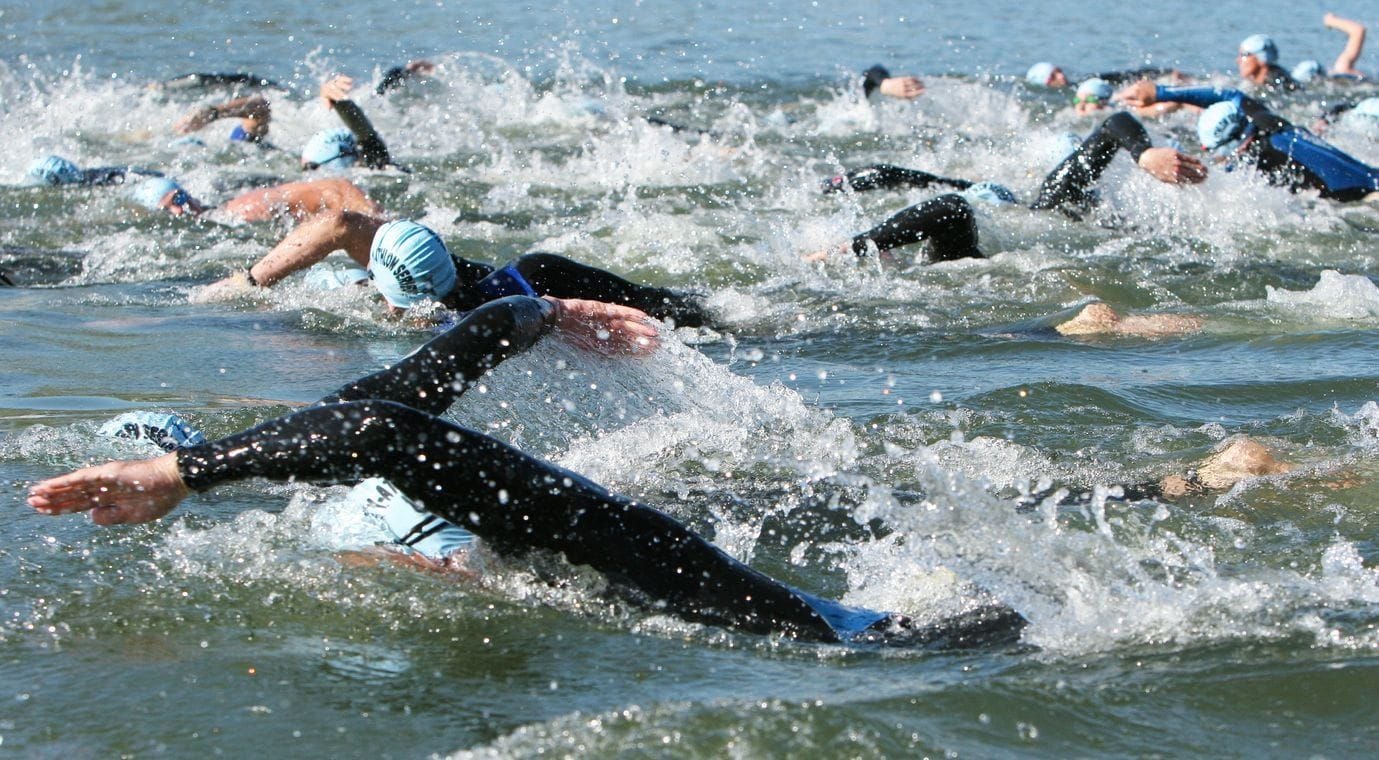Open water swimming in triathlon: Even healthy athletes need to be aware of the heart risks
)
Swimming-induced pulmonary edema may cause even healthy and experienced athletes to suffer shortness of breath and cardiovascular problems during an open water swim.
While one of the biggest mental hurdles for newcomers to triathlon is tackling the swim leg, even experienced athletes can be caught by surprise in the open water. Athlete fatalities at multisport events are actually not common when you take into account overall participation numbers. When they do occur, they receive considerable media attention. The open water swim has gained reputation as the most deadly leg of the triathlon.
Some background stats
An independent review of triathlon fatalities in the United States for the period 2006-2008 identified 14 victims (1 per 67,000 participants) in the age range of 28-65 years, with 13 of the deaths occurring during the swim leg (Harris et al., 2010). A larger review undertaken by USA Triathlon (USAT) for the period 2003-2011 identified 42 race-related fatalities (1 per 76,000 participants) in the age range of 24-76 years, with 30 of the deaths in the swim (USA Triathlon, 2012). Fatalities were not confined to inexperienced triathletes but included athletes from a broad range of triathlon experience. More contemporary research also finds that while deaths and cardiac arrests during the triathlon are not rare, most have occurred in middle-aged and older men and most sudden deaths including cardiac arrests in triathletes happen occur most frequently during the swimming component of the triathlon (Harris et al., 2017; Windsor et al., 2020).
Media reports imply that cardiac problems are wholly responsible for swimming deaths. Yet, scientific reports on the autopsy findings of triathlon victims are limited. Those that have been done show mild cardiac abnormalities were present in the majority of victims. The mechanisms of sudden fatal arrhythmia and cardiac arrest in these athletes remain unknown (Creswell, 2014).
A fundamental question
At any rate, even if cardiac abnormalities are found to be present in affected athletes, the vexing question remains: Why are athletes more vulnerable in the swim leg compared with the bike or run legs of triathlon?
There are a number of factors that might cause even healthy and experienced athletes to suffer shortness of breath and cardiovascular problems during an open water swim. Race panic, excessive hydration, sudden physical exertion and constricting wetsuits have all been documented in the literature, and, from my discussions with fellow athletes, nearly every triathlete and coach has an opinion and/or training strategy for dealing with them.
Swimming Induced Pulmonary Edema (SIPE)
There is one unusual medical problem that stands out from the others: Swimming Induced Pulmonary Edema (SIPE). Experts are still perplexed about the role of SIPE in the sudden deaths of athletes in the swim leg of triathlon.
What is SIPE?
SIPE can affect people with no underlying health problems, and while most people recover quickly if removed from the water, it may be life-threatening (Spencer et al., 2018). It is poorly understood, and hence generally under-reported. Induced pulmonary edema was first recognised in the mid-1990s when researchers focused on healthy scuba divers who experienced problems with breathlessness. It is thought that when an athlete immerses him/herself into cold water, a reflex response triggers physiological changes in the body. While this is a perfectly natural phenomenon sometimes these changes can be significant enough to cause pulmonary edema where blood leaks into the airspace of the lungs.
Estimates of SIPE incidence during open-water swimming have varied greatly. A comprehensive 2021 study (the largest population-based study of SIPE incidence in the world) reported 211 patients with SIPE among 45,915 swimmers, together completing 47,576 distances of 1,000 to 3,000 metres in cold, open water (Hardstedt et al., 2021). This corresponds to an incidence of 0.44% in a mixed group of competitive and recreational swimmers of both sexes and all ages (?18 years of age). A higher incidence of SIPE was associated with female sex and higher age.
Signs and Symptoms
Typical symptoms can include cough, fatigue, shortness of breath, and coughing up of pink frothy sputum or blood. Although SIPE can be fatal, the conventional view is that symptoms usually resolve within 24-48 hours.
In a case report published in Pulmonary Medicine (Carter & Koehle, 2011), the authors point out that many athletes may suffer a minor case of SIPE, which will simply resolve on exiting the water. The athlete may simply think he or she had a "bad day", and perhaps swallowed too much water. In serious cases, failure to recognise these symptoms and respond quickly may lead to seizures and loss of consciousness, clearly life threatening in the open water.
In the 2023 study, an extension of the 2021 study above, Kristiansson et al. observed that symptoms persisted for longer than previously assumed, with 38% of swimmers reporting more than 2 days of symptoms and 25% reporting persistent symptoms after 5 days. At 30 months, 4% of patients reported ongoing symptoms (mostly dyspnoea, cough, and reduced fitness).
What are the physiological triggers for SIPE?
Here is a simple overview of the relevant physiological mechanisms behind SIPE:
1. Cold water contacting the face during immersion activates our so-called 'mammalian diving reflex'. This reflex drives physiological changes in our body, to conserve oxygen and help us stay under water longer. Essentially, the reflex slows our heart rate and narrows the blood vessels in the extremities.
2. A slow heart rate (bradycardia) sets in, which decreases oxygen requirements of the heart muscle and sees less oxygenated blood pushed to the periphery.
3. A narrowing of blood vessels in our extremities (peripheral vasoconstriction) is triggered so that blood circulation there is shut down and redirected to our oxygen-sensitive organs (i.e., heart and brain).
4. As the blood shift takes place, blood collects in the torso (thoracic) region of the body. Blood vessels in the lungs become engorged with blood and expand, filling up the lung tissue, which leads to a shrinkage of the air sacs (alveoli) in the lungs. This sees a reduction in lung airspace volume.
5. If there is significant difference between the blood pressure in the pulmonary capillaries (small blood vessels of the lungs) and the gas pressure in the lungs, then capillary stress failure can occur. This results in leakage of blood and plasma out of the capillaries into the airspace of the lung, a condition called pulmonary edema.
Anecdotal accounts
Seasoned triathletes can be caught by surprise. A triathlete identified as klauthp (KAP) recalls their experience with breathing difficulties in a thread on swimming-induced pulmonary edema at Slowtwitch, an online forum for triathlon discussion. Their account may resonate with triathletes in the community, elite and recreational:
"The tri where I experienced SIPE was one I had done 8 times before, so I was very comfortable with the swim course, conditions and everything. That is why, when I was halfway way through my swim and my legs felt like I was dragging kettle bells, I was perplexed. I thought I might have gone out too fast, I thought I might have been too "jazzed" up. And I was convinced it was in my head. So I switched to pulling. When my arms started to shut down is when I knew something was wrong. I sighted to see if I could make it to the buoy to just "hang on" and gather my wits. I realized I couldn't make it because I had developed a cough where I couldn't seem to get any air in. At that point I waved my arm to get attention. And even that was difficult."
Take home message: Listen to your body
KAP's take home message should strike a strong chord for athletes who are highly intrinsically motivated and hell bent on completing a race despite adverse events. They highlight the imperative to listen to your body and not simply attribute symptoms to a sign of mental weakness:
"I hope my experience helps to shed light for other athletes out there. I strongly urge you to listen to your body. If something doesn't feel right, it is not right, and remove yourself from the situation. I know first hand how difficult that is to do. This was my first DNF [did not finish]. But I was lucky. I was experienced enough to know my body well - and even then I was questioning if my symptoms were all in my head."
There seems to be no way of predicting the likelihood of SIPE. Athletes like KAP report having a random, one-off event of SIPE and making a complete recovery without experiencing any repeat episodes.
Treatment involves removal of the victim from the water and emergency assistance, if required. Supportive care with rest and oxygen usually see the symptoms completely resolve.
Precautionary steps
While there appears to be no standard position or policy on best steps to avoid the likelihood of SIPE-related distress during triathlon, Dr Rudy Dressendorfer recommends the following steps to reduce the likelihood of SIPE-related swim deaths.
1. Warm up thoroughly before the swim to promote blood flow to the extremities.
2. Avoid wearing a wetsuit that restricts breathing or feels tight around the neck.
3. Submerge gradually and become comfortable with face immersion without competitive stress. If breathing difficulty is experienced on initial immersion, get out and jog in place.
4. Do an easy swim warm-up before the start. A preliminary swim will help redistribute the increased central blood volume that occurs with immersion.
5. Don’t overdrink within minutes before the swim start.
6. In the event of a panic attack discontinue the competitive effort, back float and signal for help until normal breathing is restored.
7. If possible, become habituated to the swim venue in advance, as this might attenuate race-day anxiety and its associated hyperventilation.
---
References
Carter EA, Koehle MS (2011). Immersion pulmonary edema in female triathletes. Pulmonary Medicine, 2011. doi: 10.1155/2011/261404. https://onlinelibrary.wiley.com/doi/10.1155/2011/261404
Creswell LL (2014). Triathlon fatalities aren't going away (blog). British Journal of Sports Medicine. https://blogs.bmj.com/bjsm/2014/04/25/triathlon-fatalities-arent-going-away/
Dressendorfer R (2012). Active voice: Triathlon swim deaths - initial steps toward prevention. American College of Sports Medicine, Sports Medicine Bulletin. https://www.multibriefs.com/briefs/acsm/active3-6.htm
Hardstedt M, Kristiansson L, Seiler C, Eriksson AB, Sundh J (2021). Incidence of swimming-induced pulmonary edema: A cohort study based on 47,600 open-water swimming distances. Chest, 160(5): 1789-1798. https://journal.chestnet.org/article/S0012-3692(21)01262-9/fulltext
Harris KM, Creswell LL, Haas TS, Thomas T, Tung M, Isaacson E, Garberich RF, Maron BJ. (2017). Death and cardiac arrest in U.S. triathlon participants, 1985 to 2016: A case series. Annals of Internal Medicine, 167(8): 529-535. doi: 10.7326/M17-0847. https://pubmed.ncbi.nlm.nih.gov/28975231/
Harris KM, Henry JT, Rohman E, et al. 2010. Sudden death during the triathlon (research letter). JAMA,13:1255-1257. https://jamanetwork.com/journals/jama/fullarticle/185622
Kristiansson L, Seiler C, Lundeqvist D, Eriksson AB, Sundh J, Hardstedt M (2023). Symptom duration, recurrence, and long-term effects of swimming-induced pulmonary edema: A 30-month follow-up study. Chest, 164(5): 1257-1267. https://journal.chestnet.org/article/S0012-3692(23)00947-9/fulltext
Slowtwitch Triathlon Forum. Swimming-induced pulmonary edema (discussion thread). https://forum.slowtwitch.com/t/swimming-induced-pulmonary-edema-1/593433/26
Spencer, S., Dickinson, J. & Forbes, L (2018). Occurrence, risk factors, prognosis and prevention of swimming-induced pulmonary oedema: A systematic review. Sports Medicine - Open, 4,43. https://doi.org/10.1186/s40798-018-0158-8
USA Triathlon (USAT) (2012, October). Fatality incidents study. https://undark.org/wp-content/uploads/2016/07/USATFinalReport_24OCT12-2.pdf
Windsor JS, Newman J, Sheppard M (2020). Cardiovascular disease and triathlon-related deaths in the United Kingdom. Wilderness & Environmental Medicine, 31(1):31-37. doi:10.1016/j.wem.2019.11.002. https://journals.sagepub.com/doi/10.1016/j.wem.2019.11.002
---
First published in 2015. Updated in July 2024.
| Tags:Cardiac ChallengesHeart Health for AthletesHH4ASudden Cardiac Arrest |

)